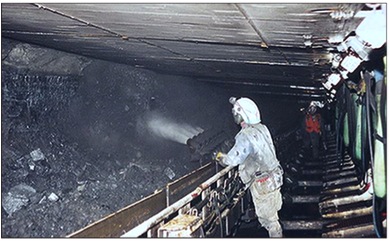GAO Report Agrees with Using Science, National Approach to Reduce Coal Mine Dust Exposure

Miner Using Water Spray to Control Coal Dust. Source: www.CDC.gov
The United States Government Accountability Office (GAO) has released a report on MSHA’s proposal to lower the exposure limit for respirable coal mine dust. The report, available here, details the basis for the proposed exposure limit, and presents possible approaches for lowering dust levels by surveying various experts in industry, academia, and government. The report implicitly casts aside the notion that black lung is a local problem, and agrees with MSHA that the disease should be addressed nationally, using epidemiological evidence. Additionally, reducing coal dust in the mine environment is necessary to preventing mine explosions similar to what occurred at Upper Big Branch.
GAO’s major finding is that MSHA based its proposal to lower coal dust levels – from 2.0 mg/m³ to 1.0 mg/m³ – on epidemiological studies, rather than on NIOSH surveillance data that establishes localized increases in cases and severity of black lung in recent years.
MSHA did not use this surveillance data because of its inherent limitations. For one, the data does not include individual miners’ past exposures to coal mine dust. This information is critical to assessing the relationship between miners’ cumulative dust exposure and their risk of developing CWP. Additionally, because participation in NIOSH’s surveillance program is voluntary, the study could have suffered from an overestimation or underestimation of the prevalence of the disease, resulting in a “participation bias.”
Instead, MSHA supported its proposal with data from two reports, which relied on six epidemiological studies. MSHA stated its intent to lower dust exposure limits back in 1996, long before NIOSH started recording spikes in black lung incidence rates. GAO determined that the rise in rates spurred MSHA to action, but did not influence the contents of the proposal itself.
This is expected to disappoint organizations like the National Mining Association, which claims that black lung is not increasing nationwide, “but only in some regional hot spots like Eastern Kentucky.” As NMA’s vice-president Bruce Watzman and Rep. Andy Barr claimed at a conference back in August, localized increases in black lung cases “[do] not justify changing the rules for the whole mining company.”
By basing its proposal on epidemiological evidence, rather than narrow set of statistical data showing a rise in black lung, MSHA confronted a broad safety issue: protecting miners nationwide, rather than in a few “regional hot spots.”
GAO consulted various experts to identify engineering controls that could help lower coal mine dust levels. The experts stressed a multi-front approach to reducing coal mine dust. Most suggestions stressed manipulating water and air in ways to either filter coal dust from the mine air, or suppress and absorb coal dust into the mine environment. These strategies ranged from enclosures, curtains and vacuums, to using hygroscopic salts to maintain the moisture content of the coal bed.
GAO also analyzed the potential economic effects of these strategies. The experts agreed that the costs might vary between the two forms of underground mining, continuous mining and longwall mining. For example, one expert noted that one way to reduce dust levels is to operate only one continuous mining machine at a time. However, this could result in significantly decreased productivity of the mine and higher costs of coal production.
GAO acknowledged many unknown variables in future technologies, but also noted that industry research on dust control has declined due to contraction of the industry. They stressed that attempts by mine operators to reduce individuals’ exposure to dust – by personal protective equipment or through administrative controls – would not lower the overall level of coal mine dust in the mine environment. And although GAO does not acknowledge this, higher levels of coal dust in mine environments add additional risks of coal dust explosions, similar to what occurred at Upper Big Branch in April 2010.
The main takeaway here is that the GAO report supports MSHA’s efforts to lower the coal dust exposure limit nationally. It is hoped that recent awareness raised by the Center for Public Integrity of black lung’s toll on communities, and the lengths to which coal companies go to deny miners the benefits they deserve, will spur lawmakers to action. As UMWA spokesperson Phil Smith recently explained, “It’s taking a really long time, and no one’s given us any reason for that.”

One Response to “GAO Report Agrees with Using Science, National Approach to Reduce Coal Mine Dust Exposure”
[…] of coal dust from 2.0 mg/m³ to 1.5 mg/m³ — half of the limit originally proposed by the Mine Safety and Health Administration and suggested by the Centers for Disease […]
Comments are closed.